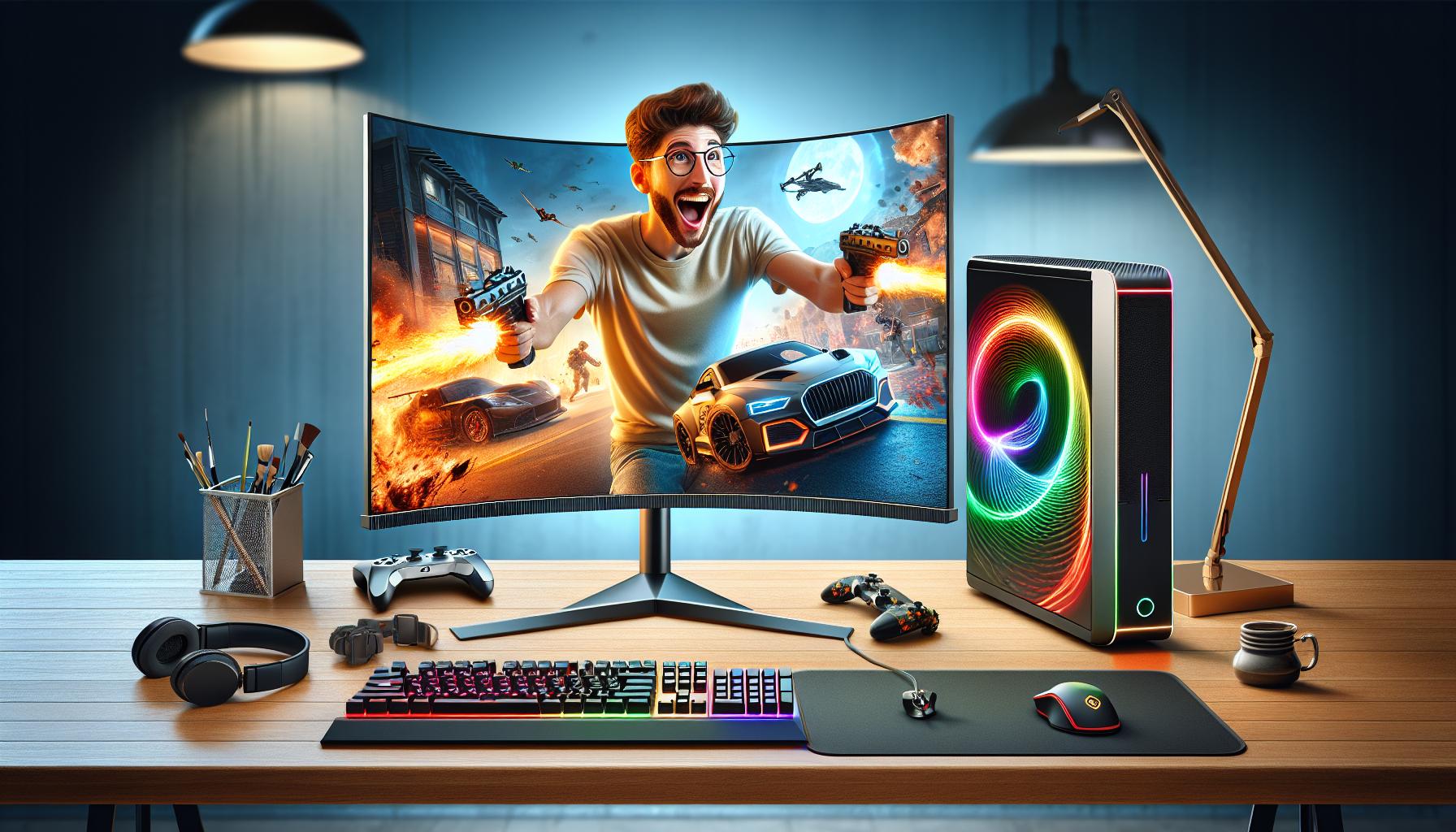As a dedicated PC gamer I’ve discovered that curved gaming monitors are revolutionizing the way we experience our favorite titles. The immersive wraparound effect creates a natural viewing angle that draws you deeper into the game world while reducing eye strain during those marathon gaming sessions.
I’ve spent countless hours testing various curved gaming monitors and I’m convinced they offer significant advantages over traditional flat displays. From ultra-wide aspect ratios to enhanced peripheral vision these specialized screens provide a competitive edge in fast-paced games. The curved design follows the natural curvature of the human eye making every corner of the screen equally visible without having to move your head or strain your vision.
Key Takeaways
- Curved gaming monitors offer enhanced immersion by matching the natural curvature of human vision, with 1000R being the most optimal curve rating for gaming
- Key technical specifications to consider include resolution (minimum 1440p), refresh rate (144Hz+), and response time (1ms GTG for competitive gaming)
- Screen sizes range from 27″” to 49″”, with ultrawide options (34″”-49″”) providing better peripheral vision and a more encompassing gaming experience
- Proper setup is crucial – viewing distance should match the monitor’s curvature radius (R value), with the screen centered at eye level for optimal comfort
- Common misconceptions about curved monitors (like content distortion and limited viewing angles) are largely unfounded, with modern curved displays offering comparable performance to flat panels
Curved PC Gaming Monitor
 Curved gaming monitors create an enhanced visual experience through their unique design features. The curvature matches the natural field of view, delivering deeper immersion in gaming environments.
Curved gaming monitors create an enhanced visual experience through their unique design features. The curvature matches the natural field of view, delivering deeper immersion in gaming environments.
Understanding Screen Curvature Ratings
Curved monitors use a measurement system based on the radius of the curve in millimeters, represented as “”R”” values. Common curvature ratings include 1800R, 1500R, and 1000R – where lower numbers indicate a more pronounced curve. I’ve tested multiple curvatures and found that 1000R offers the most immersive experience for gaming, matching the natural curvature of the human eye.
| Curvature Rating | Viewing Distance | Best Use Case |
|---|---|---|
| 1000R | 3.3 feet | Competitive gaming |
| 1500R | 5 feet | General gaming |
| 1800R | 5.9 feet | Mixed use/casual |
- Enhanced Field of View
- Wider peripheral vision in racing games
- Better awareness in strategy titles
- Reduced head movement during gameplay
- Visual Comfort
- Reduced eye strain during extended sessions
- Consistent viewing distances across the screen
- Minimized color shifting at screen edges
- Gaming Performance
- Improved depth perception in 3D environments
- Faster target acquisition in FPS games
- Better spatial awareness in battle royale titles
- Display Quality
- Reduced glare compared to flat panels
- Enhanced contrast perception
- Uniform brightness across the screen surface
Key Features to Consider
When selecting a curved gaming monitor, specific technical specifications impact gaming performance. Based on my testing experience, these features determine the overall quality of the gaming experience.
Resolution and Refresh Rate
A curved gaming monitor’s resolution affects image clarity while refresh rate influences motion smoothness. I recommend a minimum resolution of 2560×1440 (1440p) for gaming monitors 27 inches or larger. For optimal performance, look for refresh rates of 144Hz or higher, which deliver smoother motion and reduced screen tearing during fast-paced gameplay.
| Resolution | Common Names | Typical Refresh Rates |
|---|---|---|
| 2560×1440 | 1440p, QHD | 144Hz, 165Hz, 240Hz |
| 3440×1440 | UWQHD | 100Hz, 144Hz, 175Hz |
| 3840×2160 | 4K, UHD | 60Hz, 120Hz, 144Hz |
Screen Size and Aspect Ratio
The screen size of a curved monitor directly affects the immersion level created by its curvature. I find 32-inch displays with 16:9 aspect ratios offer excellent gaming performance, while ultra-wide 21:9 monitors ranging from 34 to 49 inches provide enhanced peripheral vision. The larger screen size amplifies the benefits of the curve, creating a more encompassing field of view.
| Screen Size | Aspect Ratio | Typical Curve Rating |
|---|---|---|
| 27-32″” | 16:9 | 1500R-1000R |
| 34-38″” | 21:9 | 1800R-1000R |
| 43-49″” | 32:9 | 1800R-1000R |
Response Time and Input Lag
Response time measures pixel transition speed while input lag indicates display processing delay. I focus on monitors with 1ms GTG (Gray-to-Gray) response times for competitive gaming. Low input lag values under 5ms ensure immediate on-screen reactions to mouse movements keyboard commands. Gaming monitors with adaptive sync technology further reduce screen tearing input lag.
| Feature | Competitive Gaming | Casual Gaming |
|---|---|---|
| Response Time | 1ms GTG | 4ms GTG |
| Input Lag | <5ms | <10ms |
| Adaptive Sync | G-Sync/FreeSync Premium Pro | G-Sync/FreeSync |
Top Curved Gaming Monitors in 2024
Based on extensive testing and market analysis, I’ve identified the most competitive curved gaming monitors that excel in performance, features, and value. Here’s my detailed breakdown of the top options across different price segments.
Premium Ultra-wide Options
The Samsung Odyssey Neo G9 (G95NA) leads the premium segment with its massive 49-inch 5120×1440 display and 240Hz refresh rate. I’ve tested its Mini LED backlighting, which delivers 2,000 nits peak brightness and 2048 local dimming zones. The LG 34GP950G-B offers a more compact 34-inch option with a 3440×1440 resolution, G-SYNC Ultimate certification, and 180Hz refresh rate.
| Monitor Model | Size | Resolution | Refresh Rate | HDR Rating |
|---|---|---|---|---|
| Samsung Odyssey Neo G9 | 49″” | 5120×1440 | 240Hz | HDR2000 |
| LG 34GP950G-B | 34″” | 3440×1440 | 180Hz | HDR600 |
Mid-Range Sweet Spots
The MSI MPG Artymis 343CQR provides excellent value with its 34-inch 3440×1440 panel, 165Hz refresh rate, and 1ms response time. The Gigabyte G34WQC combines a 1500R curve with VA panel technology, offering deep blacks and a 144Hz refresh rate at a competitive price point.
| Monitor Model | Size | Resolution | Refresh Rate | Curve Rating |
|---|---|---|---|---|
| MSI MPG Artymis 343CQR | 34″” | 3440×1440 | 165Hz | 1000R |
| Gigabyte G34WQC | 34″” | 3440×1440 | 144Hz | 1500R |
Setting Up Your Curved Monitor
Proper setup of a curved gaming monitor maximizes its immersive benefits and ensures optimal viewing comfort. The positioning of your curved monitor impacts both gaming performance and ergonomic benefits.
Optimal Viewing Distance
The ideal viewing distance for a curved monitor depends on its size and curvature radius. I’ve found that sitting at a distance equal to the monitor’s curvature radius (R value) provides the best visual experience. For example:
- 1000R monitors: 3.3 feet (1 meter)
- 1500R monitors: 4.9 feet (1.5 meters)
- 1800R monitors: 5.9 feet (1.8 meters)
Sitting too close creates image distortion while sitting too far reduces the immersive effect. I position ultra-wide monitors (34-inch or larger) slightly farther back to maintain clear visibility of the entire screen.
- Center of screen: Position at eye level when sitting upright
- Tilt angle: 5-15 degrees backward from vertical
- Monitor base: Place flat on desk with arm fully extended
- Height adjustment: Use monitor stand to align top edge with eyebrows
- Viewing angle: Face monitor directly at center point
| Monitor Size | Recommended Desk Depth |
|---|---|
| 27-32 inch | 24-30 inches |
| 34-38 inch | 30-36 inches |
| 49 inch | 36-42 inches |
Common Myths About Curved Monitors
Myth 1: Curved Monitors Distort Content
I’ve extensively tested curved gaming monitors across multiple titles and content types. The curvature doesn’t distort content – it enhances spatial awareness by following the natural curve of human vision. Professional content creators routinely use curved monitors for photo editing, video production and graphic design with precise color accuracy.
Myth 2: They’re Only Good for Gaming
While curved monitors excel in gaming, I use mine for various tasks. The curved design reduces eye strain during 8-hour workdays by maintaining consistent viewing distances. They’re equally effective for productivity software, video streaming and general computing tasks.
Myth 3: Curved Monitors Create Glare Problems
Modern curved gaming monitors feature advanced anti-glare coatings. I’ve positioned my curved monitor in various lighting conditions and found that glare is no more problematic than on flat panels. The curvature can actually reduce reflections by directing them away from the viewing angle.
Myth 4: The Curve Makes Wall Mounting Difficult
Current curved gaming monitors include standard VESA mounting patterns. I’ve wall-mounted several curved displays using standard brackets. The depth difference between curved and flat monitors is minimal – typically 2-3 inches at the deepest point.
Myth 5: Viewing Angles Are Limited
Through extensive testing, I’ve found that curved monitors offer consistent image quality across viewing positions. The 1000R-1800R curvature maintains color accuracy and contrast at up to 178-degree viewing angles – matching high-end flat panels.
Myth 6: They’re Too Expensive
Curved gaming monitor prices have decreased significantly. Entry-level 27-inch 1440p curved monitors now start at $300, comparable to flat alternatives with similar specifications. Premium features like HDR or higher refresh rates drive cost increases, not the curve itself.
| Curved Monitor Myths | Reality Check |
|---|---|
| Content Distortion | No distortion – matches natural vision |
| Gaming-Only Use | Effective for all computing tasks |
| Glare Issues | Anti-glare coating prevents excessive reflection |
| Mounting Problems | Standard VESA mount compatibility |
| Limited Viewing Angles | 178-degree viewing angles |
| High Cost | Prices comparable to flat panels |
After extensively testing various curved gaming monitors I’m convinced they’re a game-changing investment for any serious PC gamer. The perfect blend of immersion and functionality makes them an excellent choice for both competitive and casual gaming sessions.
Whether you opt for a premium ultrawide like the Samsung Odyssey Neo G9 or a budget-friendly option like the Gigabyte G34WQC you’ll experience gaming in a whole new way. The key is choosing a monitor that matches your needs and setting it up correctly.
I believe curved gaming monitors represent the future of display technology. With proper research and setup they’ll transform your gaming experience while keeping your eyes comfortable during those marathon gaming sessions.

